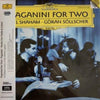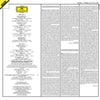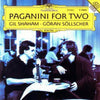





Niccolo Paganini - Paganini for Two - Gil Shaham Gil & Göran Söllscher (Digital Recording, DMM)
Composer - Niccolo Paganini
Guitar – Göran Söllscher
Violin – Gil Shaham
1LP, standard sleeve
Original analog Master tape : NO (Original Digital Master Recording)
Heavy Press : 180g Virgin Vinyl
Record color : Black
Speed : 33RPM
Size : 12'’
Stereo
Studio
Record Press : Pallas (Germany)
Label : Analogphonic
Original label : Deutsche Grammophon
Engineered by Hans-Peter Schweigmann
Produced by Christian Gansch
Audiophile direct metal mastering cut by Hans-Jorg Maucksch at Pauler Acoustics
Cover photography by Jim Rakete
Originally released in 1993 (as a CD) and 2010 (as an LP)
Reissued in January 2023
Tracks :
Side A:
Sonata concertata M.S. 2 in A Major
- Allegro spiritoso
- Adagio, assai espressivo
- Rondeau. Allegretto con brio, scherzando
Sei sonata M.S. 27, Op. 3, No. 1 in A Major
- Larghetto
- Presto variato - Variazione
Sei sonata M.S. 27, Op. 3, No. 4, in A minor
- Andante largo
- Allegretto
Sei sonata M.S. 27, Op. 3, No. 6, in E minor
- Andante
- Allegro vivo e spiritoso - Minore
Grand Sonata M.S. 3 in A Major
- Romance. Piu tosto Largo, Amorosamente
Side B:
Centone di sonate - Lettera A, No. 2 in D Major
- Adagio cantabile
- Rondoncino. Andantino, Tempo di Polacca - Minore
Centone di sonate - Lettera A, No. 4 in A Major
- Adagio cantabile
- Rondo. Andantino, Allegretto - Minore - Maggiore
Cantabile M.S. 109 in D Major
- Cantabile M.S. 109 in D Major
Introduction and Variations on "Dal tuo stellato soglio" from Rossini's Mose M.S. 23
- Introduction. Adagio
- Theme. Tempo alla Marcia
- Variation I
- Variation II. Vigoroso
- Variation III
- Finale
Moto perpetuo M.S. Op. 11, in C Major
- Allegro vivace a movimento perpetuo
Reviews:
"A glance in Grove will reveal, if you didn't know it already, that Paganini wrote a great deal of guitar music both with and without the violin, bringing together the two instruments he played so well. Paganini played these works with the guitarist/violinist Luigi Legnani who, it is said, finally protested that he always had the easy guitar parts, whilst Paganini enjoyed the violinistic limelight. However, when Paganini produced his Grand Sonata and gave the violin part to Legnani the roles were doubly reversed; the violin plays such a minor role that it is usually omitted from performances; I can recollect only one other (now deleted) recording in which it appears! As a violinist was to hand he plays his part here, from which you may judge what is (not) lost when it is omitted. The guitar parts in the Six Sonatas, Op. 3 are of student level—Segovia refused many invitations to play them—and could benefit from revision, as those in Opp. 11 and 17, adapted from the original piano parts, firmly suggest. The Sonata concertata finds the two instruments on a more even playing field, with the guitar often leading the way. This is not the music of Paganini wearing his devil's cloak but I would have liked a little more emotional fire and bite than is present in these polished and expressive performances. They are nevertheless clearly recorded, well annotated, and welcome.” John Duarte, Gramophone
Direct Metal Mastering
In Direct Metal Mastering, the cutting lathe engraves the audio signal directly onto a copper-plated master disc, instead of engraving the groove into a lacquer-coated aluminum disc.
The direct metal mastering technology addresses the lacquer mastering technology's issue of pre-echoes during record play, caused by the cutting stylus unintentionally transferring some of the subsequent groove wall's impulse signal into the previous groove wall. In particular, a quiet passage followed by a loud sound often clearly revealed a faint pre-echo of the loud sound occurring 1.8 seconds ahead of time (the duration of one revolution at 33 rpm). This problem could also appear as post-echo, 1.8 seconds after a peak in volume.
Another improvement is noise reduction. The lacquer mastering method bears a higher risk of adding unwanted random noise to the recording, caused by the enclosure of small dust particles when spraying the silvering on the lacquer master, which is the necessary first step of the electroplating process for reproduction of the master disc. As the DMM master disc is already made of metal (copper), this step is not required, and its faults are avoided.
With the groove being cut straight into a metal foil, this removed a number of plating stages in the manufacturing process. This gave rise to more upper frequency levels and less surface noise. Additionally, groove pre-echo problems are significantly diminished. Bass is typically tight and well defined, even described as more accurate than the fat, mushy sound of lacquered vinyl pressings.
Ratings:
Discogs : 4.3 / 5

